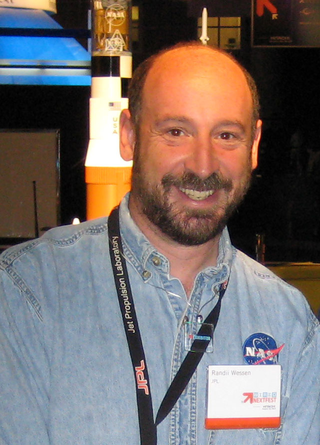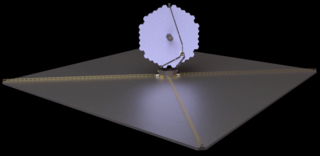
The Terrestrial Planet Finder (TPF) was a proposed project by NASA to construct a system of space telescopes for detecting extrasolar terrestrial planets. TPF was postponed several times and finally cancelled in 2011. There were two telescope systems under consideration, the TPF-I, which had several small telescopes, and TPF-C, which used one large telescope.

The Space Interferometry Mission, or SIM, also known as SIM Lite, was a planned space telescope proposed by the U.S. National Aeronautics and Space Administration (NASA), in conjunction with contractor Northrop Grumman. One of the main goals of the mission was the hunt for Earth-sized planets orbiting in the habitable zones of nearby stars other than the Sun. SIM was postponed several times and finally cancelled in 2010. In addition to detecting extrasolar planets, SIM would have helped astronomers construct a map of the Milky Way galaxy. Other important tasks would have included collecting data to help pinpoint stellar masses for specific types of stars, assisting in the determination of the spatial distribution of dark matter in the Milky Way and in the local group of galaxies and using the gravitational microlensing effect to measure the mass of stars. The spacecraft would have used optical interferometry to accomplish these and other scientific goals.
Darwin was a suggested ESA Cornerstone mission which would have involved a constellation of four to nine spacecraft designed to directly detect Earth-like planets orbiting nearby stars and search for evidence of life on these planets. The most recent design envisaged three free-flying space telescopes, each three to four metres in diameter, flying in formation as an astronomical interferometer. These telescopes were to redirect light from distant stars and planets to a fourth spacecraft, which would have contained the beam combiner, spectrometers, and cameras for the interferometer array, and which would have also acted as a communications hub. There was also an earlier design, called the "Robin Laurance configuration," which included six 1.5 metre telescopes, a beam combiner spacecraft, and a separate power and communications spacecraft.

The High Accuracy Radial Velocity Planet Searcher (HARPS) is a high-precision echelle planet-finding spectrograph installed in 2002 on the ESO's 3.6m telescope at La Silla Observatory in Chile. The first light was achieved in February 2003. HARPS has discovered over 130 exoplanets to date, with the first one in 2004, making it the most successful planet finder behind the Kepler space observatory. It is a second-generation radial-velocity spectrograph, based on experience with the ELODIE and CORALIE instruments.
Antoine Émile Henry Labeyrie is a French astronomer, who held the Observational astrophysics chair at the Collège de France between 1991 and 2014, where he is currently professor emeritus. He is working with the Hypertelescope Lise association, which aims to develop an extremely large astronomical interferometer with spherical geometry that might theoretically show features on Earth-like worlds around other suns, as its president. He is a member of the French Academy of Sciences in the Sciences of the Universe section. Between 1995 and 1999 he was director of the Haute-Provence Observatory.

Margaret Carol "Maggie" Turnbull is an American astronomer and astrobiologist. She received her PhD in Astronomy from the University of Arizona in 2004. Turnbull is an authority on star systems which may have habitable planets, solar twins and planetary habitability. She is also an expert on the use of the coronagraph in the direct detection of exoplanets.
NASA's Origins program is a decades-long study addressing the origins of the universe, various astronomical bodies, and life. The Origins program was started in the 1990s.
The Navigator Program is a long-term NASA project charged with over-seeing all missions related to the detection and characterization of Earth-like planets. It also seeks to further understand how galaxies, stars, and planets form. Navigator, with a 25-year time window, is essentially an umbrella program for more specific current and proposed projects which seek out Earth analogues and possible extraterrestrial life. The main components of Navigator include two ground-based and two space based missions.
Doris Daou is a Lebanese-born astronomer from Canada who was formerly the Director for Education and Public Outreach of the NASA Lunar Science Institute and the Associate Director of the NASA Solar System Exploration Research Virtual Institute (SSERVI), and is currently the program contact for NASA's "Small Innovative Missions for Planetary Exploration (SIMPLEx)".

Heidi B. Hammel is a planetary astronomer who has extensively studied Neptune and Uranus. She was part of the team imaging Neptune from Voyager 2 in 1989. She led the team using the Hubble Space Telescope to view Shoemaker-Levy 9's impact with Jupiter in 1994. She has used the Hubble Space Telescope and the Keck Telescope to study Uranus and Neptune, discovering new information about dark spots, planetary storms and Uranus' rings. In 2002, she was selected as an interdisciplinary scientist for the James Webb Space Telescope.

Multiple satellite imaging is the process of using multiple satellites to gather more information than a single satellite so that a better estimate of the desired source is possible. So something that cannot be seen with one telescope might be visible with two or more telescopes.

Randii Ray Wessen is an American astronautics systems engineer specifically involved in planetary exploration, experimental economist, and writer. Dr. Wessen has been an employee of the California Institute of Technology's Jet Propulsion Laboratory since 1984. He is currently the A-Team Lead Study Architect for JPL's Innovation Foundry. On the side, Wessen works with Dr. David Porter of Chapman University in the field of Experimental Economics, where they are designing a system to help allocate resources for building instruments on robotic deep space planetary spacecraft. This proposed system will build on the success of the Cassini Resource Exchange and be applied to NASA's Outer Planet Flagship Missions.

The NASA Exoplanet Science Institute (NExScI) is part of the Infrared Processing and Analysis Center (IPAC) and is on the campus of the California Institute of Technology (Caltech) in Pasadena, CA. NExScI was formerly known as the Michelson Science Center and before that as the Interferometry Science Center. It was renamed NExScI in the Fall of 2008 to reflect NASA's growing interest in the search for planets outside of the Solar System, also known as exoplanets. The executive director of NExScI is Charles A. Beichman.

The Astronomy and Astrophysics Decadal Survey is a review of astronomy and astrophysics literature produced approximately every ten years by the National Research Council of the National Academy of Sciences in the United States. The report surveys the current state of the field, identifies research priorities, and makes recommendations for the coming decade. The decadal survey represents the recommendations of the research community to governmental agencies on how to prioritize scientific funding within astronomy and astrophysics. The editing committee is informed by topical panels and subcommittees, dedicated conferences, and direct community input in the form of white papers summarizing the state of the art in each subdiscipline. The most recent report, Astro2020, was released in 2021.

The NASA Exoplanet Archive is an online astronomical exoplanet catalog and data service that collects and serves public data that support the search for and characterization of extra-solar planets (exoplanets) and their host stars. It is part of the Infrared Processing and Analysis Center and is on the campus of the California Institute of Technology (Caltech) in Pasadena, CA. The archive is funded by NASA and was launched in early December 2011 by the NASA Exoplanet Science Institute as part of NASA's Exoplanet Exploration Program. In June 2019, the archive's collection of confirmed exoplanets surpassed 4,000.

The Large Ultraviolet Optical Infrared Surveyor, commonly known as LUVOIR, is a multi-wavelength space telescope concept being developed by NASA under the leadership of a Science and Technology Definition Team. It is one of four large astrophysics space mission concepts studied in preparation for the National Academy of Sciences 2020 Astronomy and Astrophysics Decadal Survey.










